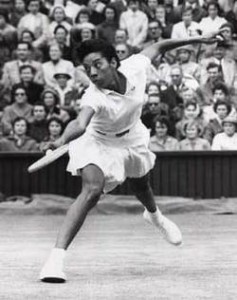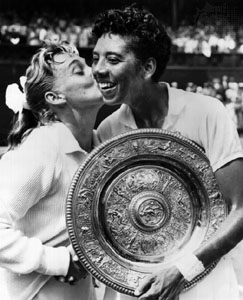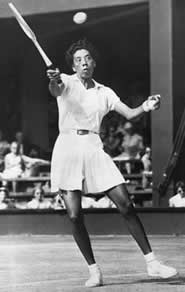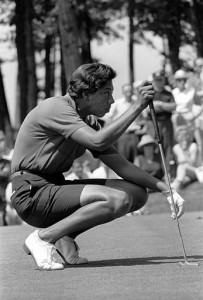Queens of the Court: Althea Gibson, A Sports Pioneer

Althea Gibson was 23 before she was allowed to compete in a major championship.
Born in 1927, the year after the historic “Match of the Century ” featured in our previous two articles between the divine Suzanne Lenglen and the poker-faced Helen Wills, Althea Gibson is another of our Queens of the Court.
In 1956 Althea Gibson made history by becoming the first person of African descent, of any nationality, to win a tennis major (the French).
Ironically, Althea Gibson became the first black woman to not only achieve major success in the world of professional tennis, but also to compete after leaving tennis as a professional golfer.
But her career in tennis was a tough row to hoe.
Unlike Suzanne Lenglen or Helen Wills, who both played their first tournaments as teenagers, and so began amassing statistics, Althea Gibson did not enter the world “tour” of tennis until the age of 23. Why?
As an African-American woman from Harlem, New York, Althea Gibson was not allowed to play the majors until in the fall of 1950, when she was allowed to enter the U.S. National Championships (later to become the U.S. Open), then played at Forest Hills.
After a half-decade spent playing in a Negro tennis league known as the American Tennis Association, adjusting to the more rigorous world of then current world-ranking players was a challenge.
In this, her first tournament in the majors, Gibson completed her first round in straight sets. But her second round match on the grass of Forest Hills would be against Louise Brough, who had won the previous three Wimbledons.

Althea Gibson defeated Darlene Hard in 1957 to win the first of her two consecutive Wimbledon titles.
After being routed 6-1 in the first set, Gibson recovered to win the second set 6-3 and led 7-6 in the third when a thunderstorm struck, halting the match. When it resumed the next day, Gibson dropped three straight games to lose the match.
A tough debut, but Gibson continued to grow her game. By 1952, Gibson was the ninth ranked American woman on the tour, and by 1956, she was among the top five in the world.
Poverty as a Germinator
Over the history of tennis in general, boys and girls of modest means succeed, but none come from poverty.
In the 1920s and 1930s, tennis in Europe was played in elite tennis clubs by the upper classes. Von Cramm was a true aristocrat, from a titled family. Fred Perry’s father was a member of the British House of Commons, and Suzanne Lenglen’s father owned a large carriage company.
Don Budge, who in contemporary terms we might call a “surfer dude” learned to play tennis in Oakland California on public courts, and came from a family of modest means.
Helen Wills was from Fremont California, which at the time was a sleepy farming community. Bill Tilden was from a wealthy family in Philadelphia.
In 1927, when Althea Gibson was born, Harlem was in the midst of what would come to be called The Harlem Renaissance. That ended with the great crash of 1929, but Harlem nonetheless, while harboring great poverty, would play host to a bohemian society.
The likes of Zora Neale Hurston, Langston Hughes, and Duke Ellington would continue to create great works of art well into the 1940s. In such an artsy, open environment, it is not inconceivable that tennis would be followed, and supported, by the African-American community of Harlem.
Althea Gibson’s family is reported to have been on public assistance, and she is reported to have been a runaway, and truant in her early years. But she excelled at sports, including basketball, horsemanship, golf, and table tennis.
At the age of 14 (when Suzanne Lenglen, Tracy Austin, Martina Hingis, and others started playing major tournaments), young Althea was introduced to tennis by a local Harlem musician and tennis fan named Buddy Walker.
Racism
As an amateur on the world tennis tour, Gibson remained unwelcome at some clubs where tournaments were held. Even while winning tournaments she was denied rooms at hotels. One refused to book reservations for a luncheon in her honor.
Zena Garrison, a WTA member in the top 20 in the ’90s has been quoted as saying that younger tennis players have no idea what it meant for Gibson to not even be allowed “in the front door.”
It had to have been tough to concentrate solely on playing the game.

Althea Gibson was 14 when she took up the game of tennis and won her first Grand Slam title at age 28.
Jackie Robinson, who similarly pioneered African-American participation in American baseball, was constantly required to block out racial slurs when he played. He had to endure a negative environment in which every mistake was held up as rationale for denying African-American’s the right to play.
At one time, Robinson received a seven-inch gash in his leg after being provoked by players on another team.
Gibson said she didn’t care. “I tried to feel responsibilities to Negroes, but that was a burden on my shoulders,” she said in 1957.
Ms. Gibson’s Game
She was tall, standing at 5’11” (compared with Suzanne Lenglen or Helen Wills, both in the 5’0″ range), with Serena Williams’ height and power, in a time when women sports figures were not so big.
A right-hander, Gibson had a strong serve and preferred to play an attacking game. A woman who had excelled at basketball as a girl, she had good foot speed.
She played a serve and volley game, but continued to learn and improve her game as the years went on, and became more consistent from the baseline.
Highlights of Her Career
Gibson won her Grand Slam titles in 1956 (French), 1957 (Wimbledon and U.S. Nationals), and 1958 (Wimbledon and U.S. Nationals). Her singles record at the Grand Slams events was an impressive 53-9: 16-1 at Wimbledon, 27-7 at the U.S., 6-0 at the French and 4-1 at the Australian.
She defeated Brough (who she had met in her first outing in a major tournament in 1950) for the 1957 Wimbledon title. She defeated Mortimer 8-6, 6-2 in the 1958 Wimbledon final and rallied to beat Hard 3-6, 6-1, 6-2 for the U.S. title.
Lost Years
It is unfortunate that Ms. Gibson’s prime tennis-playing years overlapped with some formative years in the U.S. Civil Rights movement, though perhaps we should be grateful that she was allowed to play in the latter half of her prime years.
If we assume that, like other female tennis stars before and since, that her career might have commenced at age 17, she lost a good six years out of her prime, and another three years developing her game while competing against world-class competition.

A graduate of Florida A&M, Gibson lost twice in the final of a Grand Slam and both losses were to Shirley Fry, a graduate of another Florida School, Rollins College.
When she started in the majors, she also spent time earning a bachelor’s degree at Florida A&M University. (By contrast, most tennis stars of today don’t take time away from their careers for college. John McEnroe, for example, spent only one year at Stanford University, at age 19, in 1977.)
After winning her fifth major title, Gibson turned pro. Like many tennis stars of the time, as amateurs they did not earn sufficient income to make a living.
Unfortunately, the professional Ladies’ tour in those days was slim pickings in terms of earnings, and Gibson shortly left tennis altogether for a golfing career. (Making the Ladies’ Tour a success would be a task taken up by another in our series of Queens of the Court, Billie Jean King).
Years When Althea Might Have Been Winning Majors
- 1944 – publication of An American Dilemma: The Negro Problem and Modern Democracy, which basically said that there was no reason why Negroes could not enjoy full participation in the American democracy; Duke Ellington records jazz masterpiece Black, Brown, and Beige (perhaps his most famous piece, “Take the ‘A’ Train,” was recorded in 1941, when Althea Gibson was 14)
- 1945 – deployment of the first atomic bomb and end of WWII;
- 1946
- 1947 – Jackie Robinson starts for the L.A. Dodgers (first African-American to play a major American sport)
- 1948 – Thurgood Marshall wins the Shelley v. Kraemer case, in which the U.S. Supreme Court strikes down legality of racially restrictive covenants; Martin Luther King graduates from Morehouse College
- 1949
- 1950 – Thurgood Marshall wins Supreme Court victories in two graduate-school integration cases, Sweatt v. Painter and McLaurin v. Oklahoma State Regents, laying the groundwork for the landmark Brown vs Board of Education case, which, in 1954, would demolish the legal basis for racial segregation in America

Althea Gibson also broke the color barrier in professional women's golf.
Where Gibson Stands Among Legends of the Sport After Age 24
- Lenglen: three Grand Slam singles Titles after age 24 (she turned pro)
- Gibson: five Grand Slam singles Titles after age 24 (she turned pro)
- BJK: seven Grand Slam singles Titles after age 24
- Wills: eight Grand Slam singles Titles after age 24
- Graf: eight Grand Slam singles Titles after age 24
- Court: 11 Grand Slam singles Titles after age 24
- Evert: 11 Grand Slam singles Titles after age 24
- Navratilova: 15 Grand Slam singles Titles after age 24
It’s clear from this table that Gibson probably would have stood among the legends of the sport if she’d been allowed to compete in her prime tennis years.
Read other articles in this series about women and their contributions to the game. See how 19th century American Molla Mallory pioneered the look of flowing short skirts for Ladies’ tennis and how Helen Willis came of age as an American rival of Suzanne Lenglen. Look for other articles about Billie Jean King (BJK), Martina Navratilova, Evonne Goolagong, among others.
- Althea Gibson
- Maureen Connolly
- Evonne Goolagong
- Billie Jean King
- Maria Bueno
- Margaret Court
- Steffi Graf
- Chris Evert
- Martina Navratilova
- Monica Seles
Claudia Celestial Girl is a regular tennis contributor for Bleacher Report and has graciously allowed her work in the “Queens of the Court” series to appear on Sports Then and Now.
Hi, i just thought i’d post and let you know your blogs layout is not looking good with the Safari browser. Anyhow keep up the good work. I’ll be back for more..
This is a exellent resource. Ill be back.
Thank you for the wise critique. Me & my neighbour were preparing to do some research about that. We got a very good book on that matter from our local library and most books where not as influensive as your facts. I am very glad to see this kind of details which I was searching for a lengthy time.
I am typically to running a blog and i actually appreciate your content. The article has actually peaks my interest. I’m going to bookmark your web site and hold checking for brand spanking new information.
Please tell me that youre heading to keep this up! Its so superior and so important. I cant wait to read more from you. I just feel like you know so substantially and know how to make people listen to what you’ve to say. This weblog is just as well cool to be missed. Great stuff, seriously. Please, PLEASE keep it up!
I think that you already know that your site is awesome hehe; thanks for this …
Excellent weblog right here! Also your site a lot up fast! What web host are you using? Can I am getting your affiliate link in your host? I want my website loaded up as fast as yours lol
I want to thank you for spreading this post. I really like your site and read it regularly, keep writing.
It’s wonderful that you are getting ideas from this article as well as from
our dialogue made at this time.
Here is my webpage – search
This is this form of high-quality resource which you are presenting and also you supply it away for free of charge. I love seeing weblog that understand the cost. Im glad to have decided this post as its such an exciting one! I am always on the lookout for excellent posts and articles so i assume im fortunate to have determined this! I desire you may be inclusive of more inside the future…
I want to thank you for spreading this post. I really like your site and read it regularly, keep writing.
Nice info admin. I'd like to know more about the topic.
I am always on the lookout for excellent posts and articles so i assume im fortunate to have determined this! I desire you may be inclusive of more inside the future…
Glad that i found your site today. This post is really nice and informative. The explanation given is really comprehensive and informative. thanks a lot for this nice sharing.
Sports are really interesting. If you want to win the game, you have continued to learn and improve yourself. I really like your site and read it regularly, keep writing.
An interesting dialogue is surely really worth remark. I suppose which you ought to write extra on this challenge count number